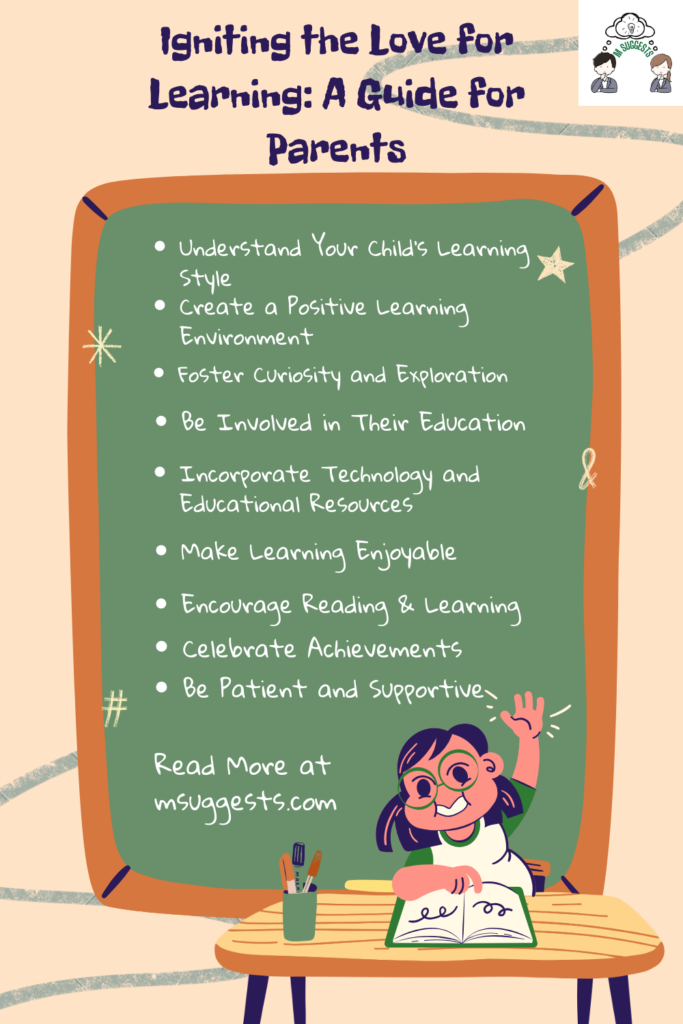Introduction
A. Unlocking the Path to Lifelong Success
In the vibrant tapestry of a child’s development, one thread stands out as foundational — the love for learning. As parents, we play a pivotal role in nurturing this passion, setting the stage for a journey marked by curiosity, exploration, and academic triumphs. Beyond mere academic achievement, instilling a love for learning equips our children with invaluable skills, fostering creativity, critical thinking, and adaptability. In this guide, we will delve into practical strategies that not only ignite the flames of curiosity in your child’s heart but also create an environment where learning becomes an exciting adventure.
B. The Importance of a Joyful Learning Experience
In an era where education transcends traditional boundaries, it’s crucial to recognize that rote memorization alone won’t suffice. Today’s young learners need more than just facts; they need an experience that captivates their minds and fuels a genuine passion for knowledge. This blog post aims to empower parents with insights and actionable tips, guiding them on how to transform the educational journey into a joyous expedition. Let’s embark on a quest to make learning an enchanting voyage of discovery for your child, a journey that extends far beyond the classroom walls.
Understand Your Child’s Learning Style
A. Decoding the Puzzle: Different Learning Styles
In the quest to nurture a love for learning, understanding your child’s unique learning style is the first stepping stone. Children process information in various ways, encompassing visual, auditory, and kinesthetic learning styles. Recognizing and embracing these individual preferences lays the groundwork for tailoring educational experiences that resonate with your child’s natural inclinations.
B. Tips for Identifying Your Child’s Learning Style
Cracking the code to your child’s learning style involves keen observation and thoughtful experimentation. Look for cues in their behavior, interests, and preferred activities. Do they excel when presented with visual aids, thrive on verbal explanations, or showcase hands-on enthusiasm? Engage in open conversations, explore diverse learning materials, and observe where their curiosity naturally gravitates. The insights gained will serve as your compass in crafting a personalized learning journey.
C. Tailoring Education to Match Their Style
Once you’ve unraveled the mystery of your child’s learning style, the next step is to tailor their educational environment accordingly. For visual learners, incorporate colorful visuals, charts, and diagrams into lessons. Auditory learners may benefit from discussions, podcasts, or audiobooks, while kinesthetic learners thrive in hands-on activities and interactive experiences. By aligning educational content with their preferred style, you transform learning from a routine into a captivating adventure uniquely suited to your child’s strengths.
Understanding your child’s learning style isn’t just a key to academic success; it’s a cornerstone in fostering a love for learning that lasts a lifetime. In the following sections, we’ll explore how to create an environment that not only accommodates but celebrates these diverse learning styles.
Create a Positive Learning Environment
A. Cultivating Success: The Power of a Supportive Atmosphere
In the journey to instill a love for learning in your child, the environment in which they learn plays a pivotal role. A supportive and positive atmosphere at home lays the groundwork for academic success and personal development. By fostering an environment that values curiosity, embraces challenges, and encourages a growth mindset, you set the stage for a fulfilling educational journey.
B. Carve Out a Dedicated Study Space
Designating a dedicated study space at home can significantly impact your child’s focus and enthusiasm for learning. Choose a quiet, well-lit area that minimizes distractions, providing them with a comfortable and organized space to explore new ideas. Personalize the study space with their input, incorporating elements that reflect their interests and fuel their motivation to engage with educational materials.
C. Infuse Fun and Creativity into Learning
Learning doesn’t have to be a mundane task; it can be an enjoyable and creative experience. Infuse an element of fun into educational activities by incorporating games, interactive lessons, and hands-on projects. By making learning enjoyable, you not only capture your child’s interest but also create positive associations with the process of acquiring knowledge. A positive learning environment is one where curiosity thrives, and every challenge becomes an opportunity for growth.
In the upcoming sections, we will delve deeper into strategies that go beyond the traditional classroom setting, ensuring that the love for learning extends seamlessly into the home environment.
Foster Curiosity and Exploration
A. Nurturing the Seeds of Curiosity
Curiosity forms the foundation of a child’s affection for learning. Cultivating a sense of wonder and encouraging questions creates a fertile ground for intellectual growth. As parents, our role is to fan the flames of curiosity by actively engaging with our children’s inquiries, no matter how trivial they may seem. By fostering a sense of curiosity, we not only stimulate their intellect but also instill a lifelong love for exploration and discovery.
B. Hands-On Learning Experiences
Children are natural explorers, and hands-on learning experiences provide them with the opportunity to actively engage with the world around them. From science experiments to arts and crafts, incorporating interactive activities into their routine not only reinforces academic concepts but also makes learning a tangible and exciting adventure. These hands-on experiences cater to various learning styles, ensuring a well-rounded and enjoyable educational journey.
C. Introduction to a Variety of Subjects
Diversifying the subjects your child encounters is key to sparking interest and curiosity. Expose them to a wide array of topics, from literature and mathematics to science and the arts. This exposure not only broadens their knowledge base but allows them to discover their passions. Whether it’s a visit to a museum, exploring nature, or reading about different cultures, encouraging exploration across diverse subjects fosters a love for learning that transcends boundaries.
In the next sections, we’ll explore practical strategies to integrate curiosity and exploration into your child’s daily routine, making learning an engaging and dynamic experience.
Be Involved in Their Education
A. Building Bridges with Teachers
Active involvement in your child’s education begins with establishing open communication with their teachers. Cultivating a positive and collaborative relationship with educators creates a support network that benefits both you and your child. Regularly attend parent-teacher meetings, inquire about your child’s progress, and seek insights into their learning style and strengths. By building bridges with teachers, you ensure a unified effort in nurturing your child’s love for learning.
B. Reviewing Schoolwork Together
Taking the time to review your child’s schoolwork together fosters a sense of partnership in their educational journey. Set aside dedicated periods to go through assignments, projects, and assessments. This collaborative approach not only allows you to stay informed about their academic performance but also provides opportunities for constructive discussions about their interests and challenges. A shared understanding of their educational experience strengthens the bond between parent, child, and teacher.
C. Active Participation in School Events
Participating in school events and activities demonstrates your commitment to your child’s education beyond the classroom. Attend parent-teacher conferences, school performances, and extracurricular events to show your support. Engaging with the school community not only provides valuable insights into your child’s social and academic life but also reinforces the idea that learning is a holistic and collaborative effort involving parents, teachers, and the student.
In the upcoming sections, we will explore ways to seamlessly integrate your involvement into your child’s learning routine, ensuring a harmonious and supportive educational environment.
Incorporate Technology and Educational Resources
A. Navigating the Digital Landscape: Integrating Educational Apps and Games
In the digital age, leveraging technology can be a powerful tool to enhance your child’s learning experience. Explore age-appropriate educational apps and games that align with their curriculum while making learning enjoyable. The interactive nature of these resources not only captures your child’s interest but also reinforces key concepts in a dynamic and engaging manner. By navigating the digital landscape together, you can transform screen time into valuable learning opportunities.
B. Selecting Age-Appropriate Educational Materials
The abundance of educational resources available can be overwhelming, making it crucial to curate content that aligns with your child’s developmental stage. Choose age-appropriate books, videos, and online courses that cater to their interests and learning style. Whether it’s exploring virtual museums, interactive e-books, or educational videos, selecting materials that resonate with your child ensures a meaningful integration of technology into their educational journey.
C. Balancing Screen Time with Traditional Learning Activities
While technology offers valuable educational resources, striking a balance with traditional learning activities is essential. Incorporate a mix of screen-based and hands-on experiences to provide a well-rounded learning environment. Encourage activities such as drawing, writing, and outdoor exploration alongside educational apps. By maintaining this equilibrium, you create a versatile learning approach that caters to different facets of your child’s development.
In the following sections, we’ll delve deeper into strategies that seamlessly blend technology with traditional methods, ensuring a comprehensive and balanced approach to your child’s education.
Make Learning Enjoyable
A. Gamify the Learning Experience
Transforming learning into a game can infuse excitement into educational activities. Introduce educational games that align with your child’s curriculum, turning lessons into interactive challenges. Whether it’s a board game that reinforces math skills or a storytelling activity that enhances language arts, gamifying the learning experience not only captures their interest but also fosters a positive attitude towards acquiring knowledge.
B. Engage in Creative and Interactive Activities
Education extends beyond the confines of textbooks and worksheets. Infuse creativity and interactivity into educational activities by incorporating arts and crafts, experiments, or even role-playing. By engaging in hands-on projects, you tap into your child’s natural curiosity and provide them with a unique and enjoyable learning experience. These creative ventures not only make learning memorable but also nurture a love for exploration and discovery.
C. Connect Learning to Real-Life Scenarios
Showcasing the practical applications of what your child is learning in school can make the educational experience more meaningful. Connect lessons to real-life scenarios, whether it’s through everyday examples, field trips, or discussions about current events. Helping your child see the relevance of their education to the world around them cultivates a sense of purpose and curiosity, making the learning journey more enjoyable and purposeful.
As we move forward, we’ll explore additional strategies to make learning a joyous and fulfilling endeavor, ensuring that your child’s enthusiasm for acquiring knowledge continues to blossom.
Encourage Reading & Learning
A. Cultivate a Reading-Friendly Environment
Creating a reading-friendly environment at home is a fundamental step in nurturing a love for books. Create a warm and inviting reading corner with snug seating and well-lit surroundings. Keep a variety of age-appropriate books within easy reach, allowing your child to explore different genres and topics. By making reading an integral part of their daily environment, you foster a positive association with books and spark their interest in diverse literary worlds.
B. Establish Dedicated Reading Time
Designate specific times for reading as part of your daily routine. Whether it’s bedtime stories, afternoon reading breaks, or family reading sessions, establishing dedicated reading time creates a sense of anticipation and ritual around books. This consistent practice not only enhances your child’s literacy skills but also cultivates a lifelong habit of reading for pleasure and knowledge.
C. Explore a Variety of Genres and Topics
Encourage a broad spectrum of reading experiences by exploring various genres and topics. Introduce fiction and non-fiction, poetry and prose, and a mix of cultural perspectives. By diversifying their reading material, you not only cater to different interests but also broaden their horizons. Celebrate their reading choices, and engage in discussions about characters, plots, and themes to deepen their understanding and appreciation of literature.
In the upcoming sections, we’ll delve further into strategies to foster a love for reading, ensuring that it becomes a cherished and integral part of your child’s learning journey.
Celebrate Achievements
A. Recognize and Acknowledge Small Milestones
In the journey of learning, every small achievement is a stepping stone toward greater success. Take the time to recognize and acknowledge your child’s milestones, whether it’s mastering a challenging concept, completing a project, or showing improvement in a particular subject. Celebrating these smaller victories builds confidence, reinforces a positive attitude towards learning, and motivates your child to embrace new challenges with enthusiasm.
B. Reinforce a Positive Attitude with Praise
Positive reinforcement through praise is a powerful tool in nurturing a love for learning. Offer specific and sincere praise for your child’s efforts, creativity, and perseverance. Whether it’s a well-written essay, a thoughtful project, or consistent dedication to their studies, reinforcing a positive attitude through acknowledgment fosters a sense of accomplishment and self-worth. This encouragement creates a supportive environment where your child feels empowered to take on new academic endeavors.
C. Use Rewards Thoughtfully
While celebrating achievements, incorporate thoughtful rewards to further motivate your child. These rewards need not be extravagant; simple gestures such as a special treat, a day out, or extra playtime can serve as effective incentives. It’s essential to tie the rewards directly to the accomplishment, reinforcing the connection between effort and positive outcomes. By using rewards judiciously, you instill the idea that hard work and dedication lead to both intrinsic and extrinsic benefits.
In the subsequent sections, we will explore additional strategies to inspire and recognize your child’s achievements, ensuring a continuous cycle of motivation and growth in their educational journey.
Be Patient and Supportive
A. Embrace the Individual Learning Journey
Every child embarks on a unique learning journey, and patience is the key to understanding and supporting their individual pace. Embrace the fact that learning milestones may vary, and each achievement, no matter how small, contributes to their overall growth. By being patient and acknowledging the distinctiveness of your child’s progress, you create a nurturing environment that encourages them to explore, learn, and evolve at their own pace.
B. Provide Emotional Support During Challenges
Learning is not always a smooth ascent; it often involves overcoming challenges and hurdles. Be a pillar of emotional support for your child during these times. Motivate them to perceive challenges as chances for personal development rather than obstacles. Listen actively, offer reassurance, and provide guidance without imposing undue pressure. Your supportive presence fosters resilience and fortitude, essential qualities for navigating the complexities of the educational journey.
C. Emphasize the Value of Effort and Perseverance
In a culture that often fixates on outcomes, it’s crucial to emphasize the value of effort and perseverance. Teach your child that the learning process itself is a triumph, regardless of immediate results. By recognizing and praising their diligence, curiosity, and commitment, you instill a mindset that values the journey as much as the destination. This approach not only cultivates a love for learning but also equips your child with essential life skills that extend beyond the academic realm.
In the subsequent sections, we will delve into practical strategies to seamlessly integrate patience and support into your parenting approach, ensuring a harmonious and constructive learning environment for your child.
Conclusion
A. Empowering Lifelong Learners
In the journey to cultivate a love for learning in your child, the significance of your role as a parent cannot be overstated. As we conclude this guide, it’s essential to reflect on the transformative power of an education nurtured with passion, patience, and purpose. By embracing your child’s uniqueness, fostering a positive learning environment, and actively participating in their educational journey, you pave the way for them to become empowered, lifelong learners.
B. Building Foundations for Future Success
The strategies explored throughout this guide are not merely steps; they are building blocks for the foundations of your child’s future success. From understanding their learning style to celebrating achievements and fostering a positive attitude towards challenges, these practices contribute to a holistic educational experience. The love for learning you instill today becomes the cornerstone of their academic achievements and personal growth in the years to come.
C. Continued Support and Exploration
As you continue to support your child’s educational journey, remember that learning is an ongoing process. Stay actively engaged, adapt strategies to their evolving needs, and celebrate the joyous moments of discovery together. By nurturing a love for learning, you empower your child to approach education with enthusiasm, curiosity, and a sense of purpose, ensuring a lifelong journey of exploration and growth.
In the spirit of continuous learning and shared exploration, we wish you and your child an exciting and fulfilling educational adventure ahead. May the love for learning be a guiding light, illuminating the path to a future filled with knowledge, creativity, and endless possibilities.

In our other blog post, we’re uncovering the best creative activities that not only bring joy but also nurture crucial developmental skills in your kids. If you’d like to read it, here is our blog post: Creative Activities for Kids





